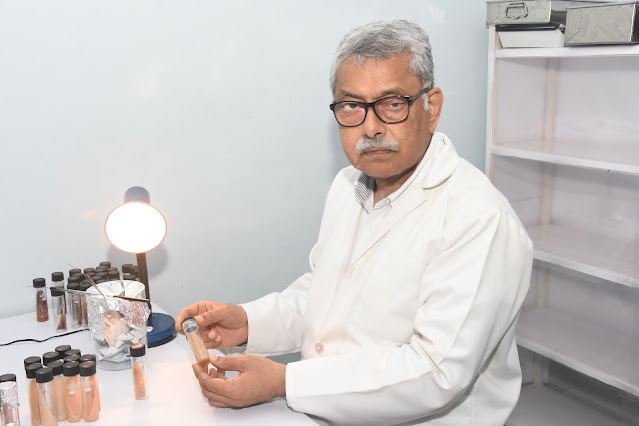- Get link
- X
- Other Apps
Scientific Contribution of GLAU Scientists in Prevention and treatment of paratuberculosis disease through Indigenous Johne’s disease Vaccine
- Get link
- X
- Other Apps
In present times our domestic livestock
is sick and down with diseases especially chronic and incurable infections like
Paratuberculosis (paraTB or pTB)/ Johne’s disease (JD), Brucellosis, bovine
Tuberculosis (bTB), etc. In the process, we are losing our precious indigenous
(desi) breeds of cows, which have been handed over to us by our forefathers.
Once we lose these breeds, the very survival of human civilization on earth may
be threatened. In view of the rampant ParaTB infection (or Johne's disease), these
cows are off-production and slowly emaciating and are let off by their owners
and are forced to roam on the roads. If we do not treat pTB in our domestic
livestock, we cannot prevent human pTB infection, since infected animals will
continue to shed Mycobacterium avium subspecies paratuberculosis (MAP) bacilli
in milk. Since MAP is not killed during the pasteurization of milk, therefore
MAP will continue to find its way into the human body by consumption of milk
and milk products by the human population and by our children, made from
pasteurized milk. Early detection of infection and removal by culling and
segregation of infected animals are some of the technologies used to control
the disease. However, cows cannot be culled in India for religious reasons; therefore,
there is a need for the development of a vaccine.
Bio-load of MAP in the Indian domestic livestock population has shown an increasing trend in the last 28 years. Of the four domestic livestock species in India, bio-load of MAP has been reported to be highest (16.0–54.7%) in the sheep population, followed by 28.3–48.0% in buffaloes, 6.0–39.3% in cattle, and 9.4–20.1% in goats. Once this disease enters any herd it becomes established and endemic, since MAP is passed from one generation to another through semen, during pregnancy, by feeding of milk and colostrums, and by oral-fecal route from contaminates the environment and enters the human food chain leading to potential public health issues. In severely affected herds, losses are difficult to estimate since animals get culled early on health and production grounds; therefore, there is loss of the elite germ-plasm developed through many years of genetic selection and breed improvement programs. Despite the very high slaughter rate of domestic livestock (goats, sheep, and buffaloes) to meet the ever-growing demand for meat for domestic consumption and export, the bio-incidence of JD continues to increase and has become endemic in several herds in the country. In addition, ‘test and cull’ is not an economically viable option for third-world countries like India. Furthermore, the ‘test and cull’ methodology has not yielded assured results in goats, though still practiced to reduce environmental contamination by removing shedder goats. Similar findings have been reported in other parts of the world with respect to goats, buffaloes, and cattle, where the 'test and cull' methodology has been in use for a long time but was found to be ineffective, therefore switched to vaccination for the control of the disease.
 |
| Pic: Collection of pTB samples from goat origin strain of MAP ‘S5’ ‘Indian bison type’ |
Vaccines for
pTB disease have been demonstrated and used to control disease and treat
infected animals. On using this vaccination, it has been found that this vaccine
is more effective than the vaccine imported from outside for the control of
this disease in our country. It is safe since being an inactivated vaccine and
once applied it provides protection against this disease throughout life.
Vaccination has been used for disease control in Britain, Australia, and
Iceland, etc. The presence of the disease has come down from 35% to 1%. The
effect of this inactivated vaccine of pTB has been seen to be very positive,
apart from this, the continuous use of the vaccine is helpful in increasing the
immunity of animals and also reduces the bio-load of the environment.
Recently an
‘Indigenous Johne’s Disease Vaccine’ has been developed by Dr. Shoor Vir Singh
(Former Principal Scientist and Head, Animal Health, Division, ICAR- Central
Institute for Research on Goats, Makhdoom, Mathura) and his team (Dr. Saurabh
Gupta and Dr. Kundan Kumar Chaubey) using goat origin strain of MAP ‘S5’
‘Indian bison type’ for the control of pTB in domestic ruminants (Goat, sheep, cow,
and buffaloes). On using this vaccination, it has been found that this vaccine
is more effective than the commercially available vaccine imported from other
countries. It is safe due to being an inactivated vaccine and once applied
provides protection against this disease throughout life.
 |
| Pic: Indigenous Johne’s disease Vaccine (left: Dr. Kundan Kumar Chaubey; middle: Prof. Shoorvir Singh; right: Dr. Saurabh Gupta) |
To save and protect our
native breeds of cows, Shri Narayan Das Agrawal, Chairman and Chancellor of GLA
University, Mathura took a step ahead. University has provided 18-20 lakh
rupees to run this vaccination scheme in a big way. In the next six months,
this vaccine will be ready and can be used in cows and other animals. For the
prevention of this disease, permission has been given by Shri Krishna Gopal Ji
to start the vaccination program from Hasanand Gaushala, Vrindavan, Mathura.
Gradually, by spreading this program in the entire Braj Mandal, it will prove
to be a milestone in the improvement, conservation, and production of cows.
Later the idea is to spread this program all over the state, country, and
abroad. This scheme will accomplish the proverb of “Think Globally but Work
Locally”. Vaccination should be followed along with other managed improvements
to prevent disease transmission in susceptible animals and the human population
including little babies and children.
- Get link
- X
- Other Apps
Comments
Great Going @ GLA University, Mathura.
ReplyDeleteNice sir 👍👍👍👍
ReplyDeleteCongratulations doctor sahib.Wishing good luck for many more achievements in the days to come.
ReplyDeletecongratulations sir🙏
ReplyDelete